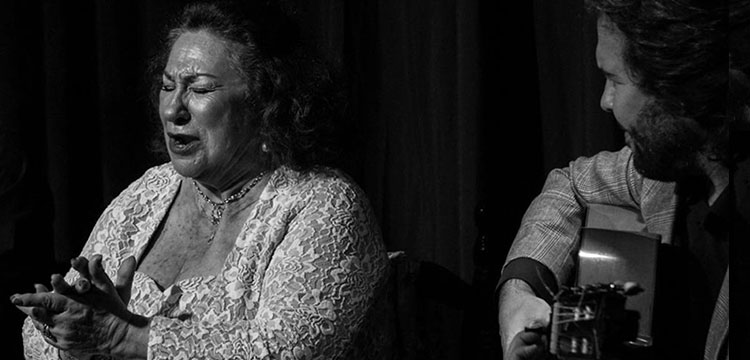María Vargas at the Sala García Lorca in Madrid
Guitar: Miguel Salado. Rhythm: Miguel Téllez & Noe Barroso
José Manuel Gómez Gufi
María Vargas’ concert ended with a Spanish Christmas song “because I’m not going to be in Madrid for the holidays”, and she sang it full out, with no respite of any kind for the audience at the García Lorca room consisting of flamenco followers, fans who have the custom of living flamenco as a brotherhood, and newcomers who want to feel the experience. At the bar alongside, one hour before the show, there are two groups who alternate between Spanish and English, wine, tapas, French and beer. One of the foreigners looks my way as if he knew me, but what he really recognizes is the image of Miles Davis on my T-shirt.
Going to hear María Vargas is a lot like attending church on Sunday, the conversation is sprinkled with the hot topic of Rosalía, which is like discussing graffiti in the Sistine Chapel, a lack of sensitivity that is best taken on with the naturalness of knowing that times change and the classics remain.
Vargas started out with alegrías, and the best thing was the verse that spoke of nostalgia for Camarón who for many of those of us in attendance, was the key that opened the flamenco treasure chest and also the windows to be able to see new horizons. It’s warm in the room and one lady in the audience offers the singer a fan, while another person requests mining songs of Levante. María has her plan: “I’m going to sing tientos-tangos”, and that’s when what we came to hear starts happening. She announces fandangos and then the intermission.
On the program, María was announced as “Professor and maestro of gypsy song 1962”, and on the handbill for the day, “winner of the National Flamenco Prize of Jerez de la Frontera 1998”. Between one thing and another, she recorded with the Moraos, the Habichuelas, with Paco de Lucía and with Manolo Sanlúcar from her hometown, so she has traveled through the history of the flamenco art-form which – despite what they say – continues to be an art of a select few.
María Vargas gives her singing lesson and delivers tangos del Piyayo, and when it comes time for siguiriyas, she employs a half-voice, as if she were talking about intimate things that she knows are going to hurt, but which you’ll also like, but always always she has a supplement. I’ve already told you, I’ve learned to listen to siguiriyas as if I were listening to John Contrane who here sounds like blues or negro spirituals without the flourishes he got involved in during the latter part of his career. It works for me, and Coltrane never lets you down, nor does María Vargas. We’re a dozen or so applauding what the singer just did as if it were the first time, and she moves her feet as if she’s just landed from another planet and she finishes with bulerías that turn out to be another lesson. The above-mentioned Christmas song rounds out the evening and you leave the Sistine Chapel wondering whether to pray or paint the walls with graffiti.
Videos:
Photos:
Photos & videos: Rafael Manjavacas
